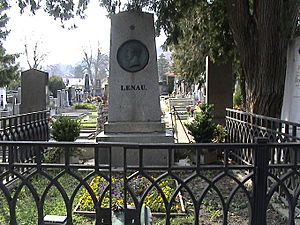Nikolaus Lenau facts for kids
Nikolaus Lenau was the pen name (a name a writer uses instead of their real one) of Nikolaus Franz Niembsch Edler von Strehlenau (born August 13, 1802 – died August 22, 1850). He was an Austrian poet who wrote in German.
Biography
Nikolaus Lenau was born in Csatád, which was then part of the Kingdom of Hungary. Today, this place is called Lenauheim and is in Romania. His father, who worked for the Habsburg monarchy (a powerful empire), died in 1807. This left Nikolaus and his siblings to be raised by their mother. She remarried in 1811.
In 1819, Nikolaus started studying at the University of Vienna. He later studied Hungarian law and then spent four years studying medicine. However, he found it hard to settle into any one job. Instead, he started writing poetry. He often felt sad or gloomy, a trait he inherited from his mother. This feeling grew stronger due to disappointments in love and the popular style of poetry at the time, called romanticism, which focused on strong emotions. After his mother died in 1829, his sadness deepened.
Soon after, he received money from his grandmother. This allowed him to focus completely on writing poems. His first poems were published in 1827. In 1831, he moved to Stuttgart, Germany. There, he published a collection of poems called Gedichte (1832). He also met other famous poets like Ludwig Uhland.
Lenau's restless spirit made him want a change. He decided to travel to America, hoping to find peace and freedom there. In October 1832, he arrived in Baltimore and tried living on a farm in Ohio. He also spent six months in New Harmony, Indiana, with a group called the Harmony Society. But life in the wild American forests was not as good as he had imagined. He didn't like Americans, saying they were "always talking about money." So, in 1833, he returned to Germany. The good reviews of his first book of poems cheered him up.
From then on, he lived partly in Stuttgart and partly in Vienna. In 1836, his poem Faust was published. In this work, he openly shared his deepest feelings. In 1837, he wrote Savonarola, a long poem that talked about how being free from strict government and old ways of thinking was important for true Christianity. In 1838, his Neuere Gedichte (Newer Poems) showed that Savonarola had been written during a brief moment of strong positive feelings. Some of his best new poems were inspired by his strong, unrequited love for Sophie von Löwenthal, who was the wife of a friend. In 1842, Die Albigenser was published. In 1844, he started writing his Don Juan, but only a part of it was published after his death.
Soon after, he began to show signs of mental illness. In October 1844, he jumped from a window one morning and ran down a street, shouting. He was then taken to a special hospital for people with mental illness and stayed there for the rest of his life. He died in the asylum near Vienna and was buried in Weidling, near Klosterneuburg. His grave has a replica of an open book with lines from his poems.
The city of Stockerau in Austria calls itself "Lenau City." This is because Nikolaus Lenau often walked in the forests near Stockerau and the Danube river. These walks inspired him to write one of his most famous poems, "Schilflieder." Many streets and squares in Vienna and nearby areas are named after him.
Lenau's political poems, like "By the Grave of a Minister," show that he believed in more freedom. He criticized the strict government and some problems he saw in the Catholic Church. Lenau is mostly famous for his shorter poems. Even his longer poems, called epics, feel like shorter, more personal ones. His excellent poem, "Herbst" (Autumn), expresses the sadness he felt after his stay in the United States and his difficult journey back to Europe. In it, he mourns losing his youth and the passing of time. He also feels a sense of futility. This poem is a perfect example of Lenau's writing style. It ends with the writer thinking about death as a way to escape feeling empty. He is considered the greatest modern lyric poet of Austria. He represents the feeling of Weltschmerz (a deep sadness about the world) in German literature, which started with Lord Byron and reached its peak in the poetry of Giacomo Leopardi.
Legacy
Many composers have been inspired by Nikolaus Lenau's poems:
- Composer Marie Schauff (who lived from 1799 to 1844) set some of Lenau’s poems to music in her work “Gedichte von Lenau.”
- Robert Schumann, a famous composer whom Lenau met in 1829, set six of Lenau's poems to music in his Sechs Gedichte und Requiem, Op. 90. This music was composed in 1850, and Lenau died on the day it was first performed.
- Songs like “Die Nacht” and “Die Sennin” by Sophie Seipt (1812-1889) are based on Lenau's poems.
- Songs by composer Pauline Volkstein (1849-1925) also use text by Lenau.
- Notturno, a song cycle from 1933 by Othmar Schoeck, includes music for nine of Lenau's poems.
- The composer Heinz Holliger wrote a song cycle called Lunea (2013) using Lenau's texts. He also created an opera, also named Lunea, based on the song cycle.
- Lenau's Don Juan inspired the German composer Richard Strauss's famous musical piece Don Juan, Op. 20.
See also
 In Spanish: Nikolaus Lenau para niños
In Spanish: Nikolaus Lenau para niños



